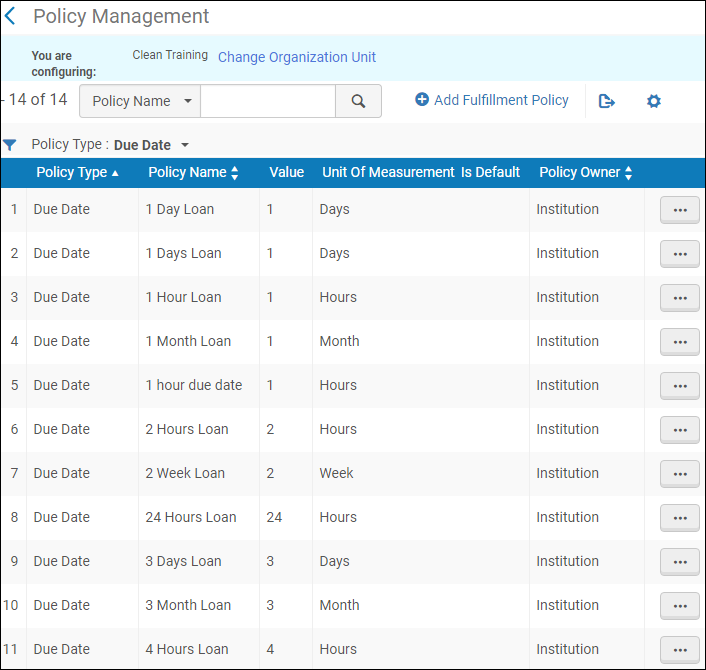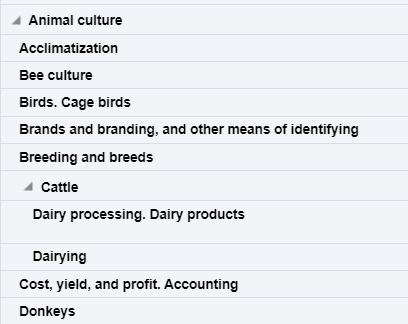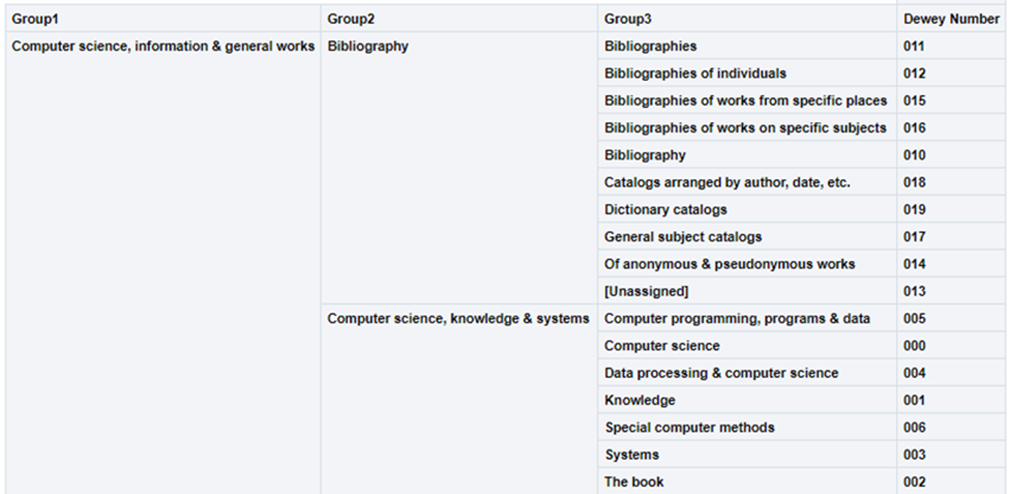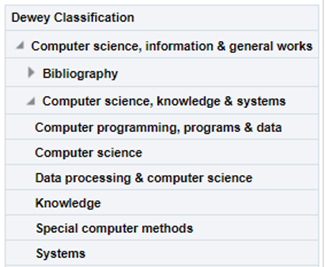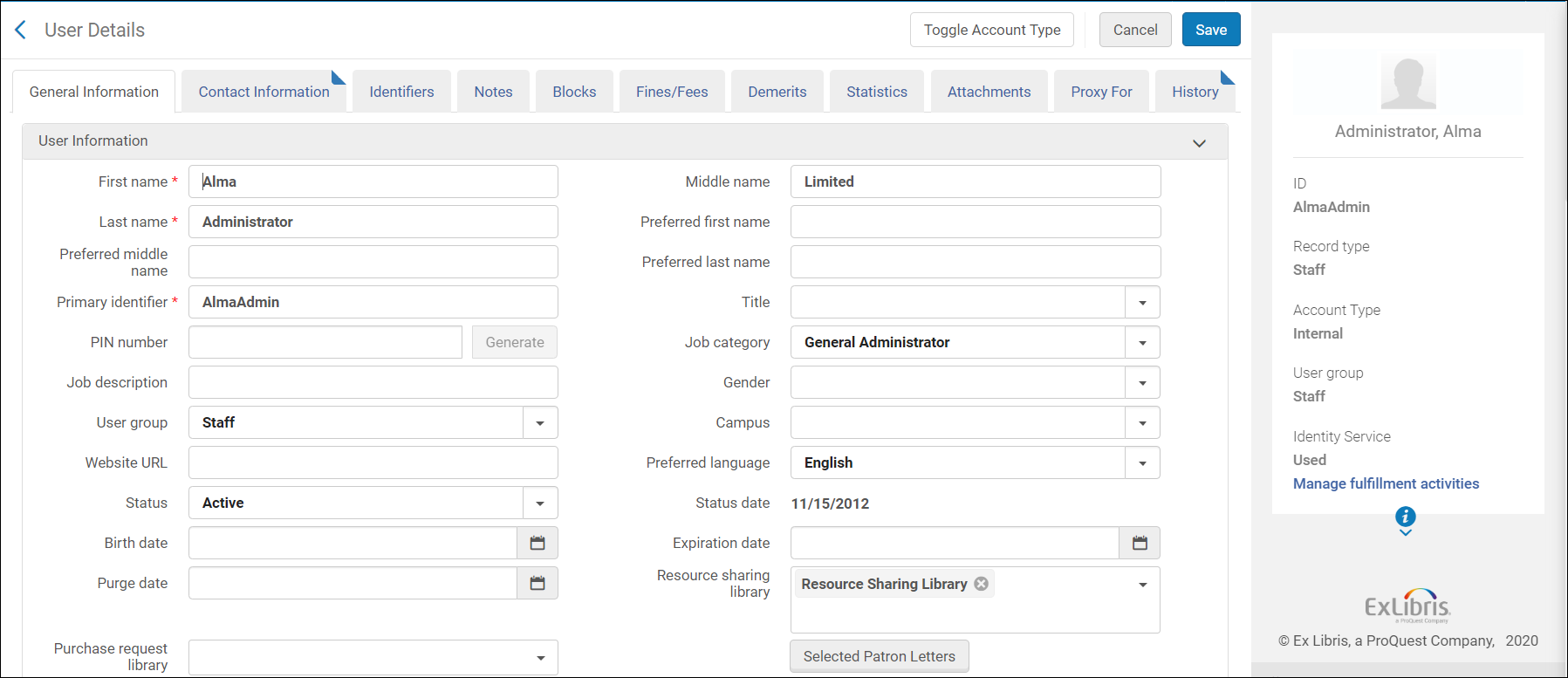Fulfillment
- How many items were loaned, returned, or lost per library?
- How many items were loaned between specific loan dates?
- How many items were loaned from a particular circulation desk?
- What is the due-date policy of the loaned items?
- How many items were loaned per classification?

- The Fulfillment subject area contains items for which there has been at least one loan. Items with no loans are not reportable in the Fulfillment subject area; they may be retrieved instead in the Physical Items subject area using a loan measure = 0.
- The measure and date fields in the Fulfillment subject area may not include migrated data, depending on the migrating system. However, the Loan measures never include migrated data.
-
Any fulfillment transaction completed before the value of the Institution > Data updated as of field will be reflected in an Analytics report run after the value of the Institution > Data available as of field. For more information, see Introduction to Analytics and Terminology.
Field Descriptions
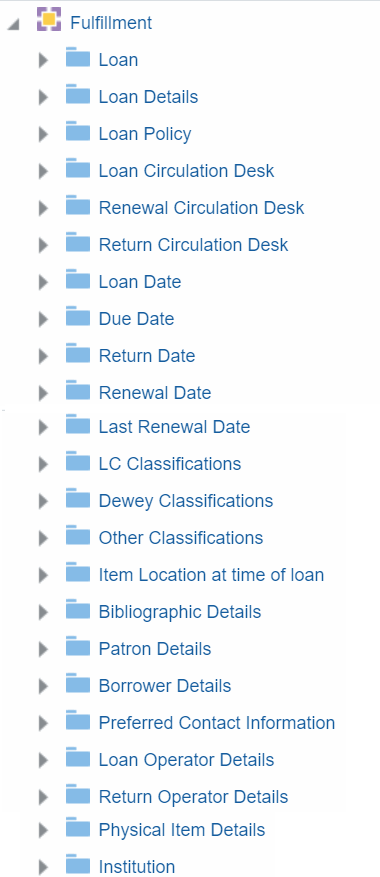
Loan
Report Creation Tips
- Filtering results using the In House Loan indicator
In house loans are used to monitor items that were used in the library, but not actually loaned. When a return is made on an item that was not loaned, an in-house loan is created for it.Some industry reports require that these loans be included in the loan count and others do not; therefore, use a filter to include or exclude these results from your loan count, as necessary.
 In House Loan Indicator FilterThe In-House Loan Indicator field is located in the Loan Details folder.
In House Loan Indicator FilterThe In-House Loan Indicator field is located in the Loan Details folder. - Distinguishing between self-check transactions and staff transactions
Although there is no specific field that indicates the difference between self-check transactions and staff transactions, you can distinguish between the two based on the fact that the Loaned By\Returned By name for self-check machines is None.
- Filter for returns:
CASE WHEN "Returned By"."User Name" = 'None' THEN 'Self-Check Machines' ELSE 'Staff 'END
- Filter for loans:
CASE WHEN "Loaned By"."User Name" = 'None' THEN 'Self-Check Machines' ELSE 'Staff ' ENDq2
- Filter for returns:
Guidelines for Using Filters Based on Loan and Renewal Dates
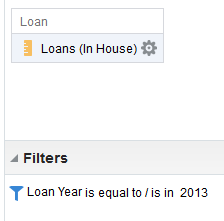
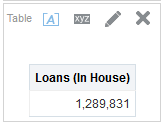
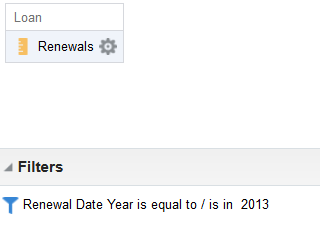
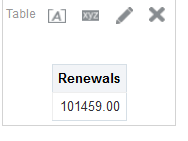
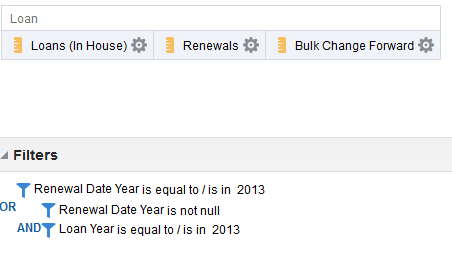

| Field | Description | Additional Information |
|---|---|---|
| Num of Loans (In house + Not In House) | The sum of the in house loans and the not in house loans. | |
| Num of Loans (In House) | The number of items that were used in the library, but not actually loaned | |
| Num of Loans (Not In House) | The number of items that were actually loaned | |
| Loans (Not In House) from Hold Request | The number of not in house loans that came from a hold request | |
| Loans (Not In House) from Booking Request | The number of not in house loans that came from a booking request | |
| Loans (Not In House) from Resource Sharing Borrowing Request | The number of not in house loans that came from a resource sharing borrowing request | |
| Returns | Populated with 1 if the loan status is Complete; otherwise, it is populated with 0. | |
| Recalls | The number of times the item was recalled | |
| Renewals | The number of times the item was renewed |
This number includes both manual and via a self-check machine, but does not include auto-renewals. The Renewals can be combined in a report with fields from the "Renewal Date" folder to report on the number of renewals per time period. The Renewals can be combined in a report with fields from the "Renewal Date" folder to report on the number of renewals per time period. |
| Auto Renewals | The number of times the item was automatically renewed. | In Alma Analytics, Auto Renewals are not associated with a date and therefore combining Auto Renewals with fields from the "Renewal Date" folder is not supported. |
| Lost | Populated with 1 if the item is lost and never located; otherwise, it is populated with 0. | |
| Claimed Returns | Populated with 1 if the patron claims that the item was returned and the item was never located located; otherwise, it is populated with 0. | |
| Reading Room at Shelf | The number of times the item was returned by the patron to the reading room. If the loan is not from the reading room, the value of this field is 0. | |
| Reading Room at User | The number of times the item was loaned to the patron from the reading room. If the loan is not from the reading room, the value of this field is 0. | |
| WB Change Backward | The number of times the workbench due date was changed to an earlier date by a circulation desk operator at the circulation desk | |
| WB Change Forward | The number of times the workbench due date was changed to an later date by a circulation desk operator at the circulation desk | |
| Bulk Change Backward | The number of times the item was changed to an earlier date as part of a bulk change | |
| Bulk Change Forward | The number of times the item was changed to a later date as part of a bulk change | |
| Loan Days | The number of days between the loan date and the return date | |
| Return Due Days | The number of days between the return date and the due date | |
| Return After Lost | The number of items returned with the Lost process status. |
Loan Details
| Field | Description | Additional Information |
|---|---|---|
| Author | The author of the loan | |
| Associated Course Code | The code of a course that was active during the time the item was loaned. The item belonged to a citation that was part of the reading list of the course. | |
| Associated Course Name | The name of a course that was active during the time the item was loaned. The item belonged to a citation that was part of the reading list of the course. | |
| Barcode | The barcode of the item that was loaned | This field is limited to 128 characters. |
| Call Number | The call number of the item that was loaned | |
| Courtesy Notification Sent | Indicates if a courtesy letter was sent to the patron concerning an overdue loan. | This field only contains data beginning from July 2018. |
| Description | The description of the loan | |
| Dewey Classification Top Line | The first 3 digits of the Dewey classification | |
| Due Date | The current due date as displayed in Alma | The new due date can differ from the original due date due to a recall or renewal |
| Due Date Time | The time in the hours:minutes:seconds format of the new due date | |
| In House Loan Indicator | Y/N field that indicates if the loan is an in-house or a regular loan. Null means that it is not an in-house loan. | |
| In Temp Location at Time of Loan | Y/N field that indicates if the loan is a temporary location at the time of the loan | |
| Is Booking Loan | Indicates whether the loan was initiated by a booking request | |
| Is Hold Request Loan | Indicates if the loan was initiated by a hold request | |
| Is Resource Sharing Borrowing Request Loan | Indicates if the loan was initiated by a resource sharing borrowing request | |
| Item ID | The ID of the item that was loaned | |
| Item Loan ID | The unique ID of the loan for the item | This is useful to find a specific loan of an item |
| LC Classification Code | The letters of the LC class number of the item that was loaned such as BF or QA | In the Fulfillment subject area, if there is more than one classification code in the bibliographic record, the last one appears. |
| LC Classification Number | The numbers that follow the classification letters until the first period that is followed by a letter | |
| LC Classification Top Line | The combined LC code and classification numbers until the first period followed by a letter such as NB933 when the lc_class_number is NB933.F44 | |
| Loan Date | The date of the loan | |
| Loan Note | The last note attached to the loan | This includes both manual free text additions by staff, as well as automatic notes added by Alma according to your configurations, such as for overridden blocks. |
| Loan Status | Indicates if the loan is active or has already been returned; also known as historical loan | Possible values:
|
| Loan Time | The time of the loan | |
| Loaned at Another Institution | Indicates if the item was loaned at an institution different than the one that owns the item | |
| Loaned at Institution Name | The name of the institution at which the item was loaned | |
| Loans - Linked From Institution Code | The code of the institution from which the user is linked | The information for this field comes from the loan record. Therefore, data is displayed even for institutions that anonymize their user records. |
| Loans - Linked From Institution Name | The name of the institution from which the user is linked | The information for this field comes from the loan record. Therefore, data is displayed even for institutions that anonymize their user records. |
| Loans - Linked From Other Institution | Indicates if the user is linked from another institution | The information for this field comes from the loan record. Therefore, data is displayed even for institutions that anonymize their user records. |
| Location Code | The location code of the loan | |
| Material Type | The material type of the loan | |
| Material Type | The material type of the loan | |
| MMS ID | The MMS ID of the loan | |
| New Due Date | The new due date of the loan | |
| New Due Time | The new due time of the loan | |
| Original Due Date | The original due date given to the loan | This field is populated only when the loan is "Recall" |
| Original Due Time | The time in the hours:minutes:seconds format for the original due date | |
| Patron Expiry Date | The date that the patron's user account expires in the library | For the date that the patron's user account expires in the institution, use Borrower Details > Expiry Date. |
| Process Status | Indicates the workflow status of the loan, based on the last activity of the loan | Possible values:
|
| Publication Year | The publication year of the loan | |
| Recall Date | The date on which the item was recalled | |
| Recall Time | The time in the hours:minutes:seconds format for the recall date | |
| Return Date | The return date of the loan | |
| Return Time | The return time of the loan | |
| Title | The title of the loan | |
| User ID Encryption | The Encryption ID of the User | This ID is used to get counts by user ID after the anonymization job is run, which deletes the Primary ID |
Loan Policy
Loan Circulation Desk
| Field | Description | Additional Information |
|---|---|---|
| Campus Code | The code of the campus to which the circulation desk is connected. | |
| Campus Description | The description of the campus to which the circulation desk is connected. | |
| Campus Name | The name of the campus to which the circulation desk is connected. | |
| Circ Desk Code | The code of the circulation desk | |
| Circ Desk Desc | The description of the circulation desk | |
| Circ Desk Name | The name of the circulation desk | |
| Has Self Check | Indicates whether the circulation desk has a self-check machine | |
| Hold Shelf | Indicates whether the circulation desk has the ability to hold items for patron requests | |
| Hold Shelf Period | Indicates the amount of time an item is held on the shelf for a patron before being returned | |
| Hold Shelf Sort | The way items are physically stored on the shelf such as requester name, title, and date, for example. | |
| Library Code | The library code to which the circulation desk is connected | |
| Library Desc | The library description to which the circulation desk is connected | |
| Library Name | The library name to which the circulation desk is connected | |
| Payment Cash | Indicates whether the circulation desk accepts payments in cash | |
| Payment Credit Card | Indicates whether the circulation desk accepts payments by credit card | |
| Primary Indicator | Indicates whether the circulation desk is able to send/accept items that need to be transferred out of the library | |
| Print Receipt | Indicates whether the circulation desk prefers payment receipts to be printed automatically | |
| Reading Room Desk | Indicates whether the circulation desk is a desk in a reading room where items cannot be removed from the room | |
| Loaned at Institution Circulation Desk | The circulation desk at which the item was loaned at an institution that does not own the item | |
| Loan Circulation Desk | The is Hierarchy column that allows the user to drill down from the campus to the library to the loan circulation desk. This column provides the user with the option to view the accumulative measures in each level of the hierarchy. |
Renewal Circulation Desk
| Field | Description | Additional Information |
|---|---|---|
| Renewal Campus Code | The code of the campus to which the circulation desk is connected. | |
| Renewal Campus Description | The description of the campus to which the circulation desk is connected. | |
| Renewal Campus Name | The name of the campus to which the circulation desk is connected. | |
| Renewal Circ Desk Code | The code of the circulation desk | |
| Renewal Circ Desk Desc | The description of the circulation desk | |
| Renewal Circ Desk Name | The name of the circulation desk | |
| Renewal Has Self Check | Indicates whether the circulation desk has a self-check machine | |
| Renewal Hold Shelf | Indicates whether the circulation desk has the ability to hold items for patron requests | |
| Renewal Hold Shelf Period | Indicates the amount of time an item is held on the shelf for a patron before being returned | |
| Renewal Hold Shelf Sort | The way items are physically stored on the shelf such as requester name, title, and date, for example. | |
| Renewal Library Code | The library code to which the circulation desk is connected | |
| Renewal Library Desc | The library description to which the circulation desk is connected | |
| Renewal Library Name | The library name to which the circulation desk is connected | |
| Renewal Payment Cash | Indicates whether the circulation desk accepts payments in cash | |
| Renewal Payment Credit Card | Indicates whether the circulation desk accepts payments by credit card | |
| Renewal Primary Indicator | Indicates whether the circulation desk is able to send/accept items that need to be transferred out of the library | |
| Renewal Print Receipt | Indicates whether the circulation desk prefers payment receipts to be printed automatically | |
| Renewal Reading Room Desk | Indicates whether the circulation desk is a desk in a reading room where items cannot be removed from the room | |
| Renewal Loan Circulation Desk | The is Hierarchy column that allows the user to drill down from the campus to the library to the loan circulation desk. This column provides the user with the option to view the accumulative measures in each level of the hierarchy. |
Return Circulation Desk
| Field | Description | Additional Information |
|---|---|---|
| Campus Code | The code of the campus to which the circulation desk is connected. | |
| Campus Description | The description of the campus to which the circulation desk is connected. | |
| Campus Name | The name of the campus to which the circulation desk is connected. | |
| Circ Desk Code | The code of the circulation desk | |
| Circ Desk Desc | The description of the circulation desk | |
| Circ Desk Name | The name of the circulation desk | |
| Has Self Check | Indicates whether the circulation desk has a self-check machine | |
| Hold Shelf | Indicates whether the circulation desk has the ability to hold items for patron requests | |
| Hold Shelf Period | Indicates the amount of time an item is held on the shelf for a patron before being returned | |
| Hold Shelf Sort | The way items are physically stored on the shelf such as requester name, title, and date, for example. | |
| Library Code | The library code to which the circulation desk is connected | |
| Library Desc | The library description to which the circulation desk is connected | |
| Library Name | The library name to which the circulation desk is connected | |
| Payment Cash | Indicates whether the circulation desk accepts payments in cash | |
| Payment Credit Card | Indicates whether the circulation desk accepts payments by credit card | |
| Primary Indicator | Indicates whether the circulation desk is able to send/accept items that need to be transferred out of the library | |
| Print Receipt | Indicates whether the circulation desk prefers payment receipts to be printed automatically | |
| Reading Room Desk | Indicates whether the circulation desk is a desk in a reading room where items cannot be removed from the room | |
| Return Circulation Desk | The is Hierarchy column that allows the user to drill down from the campus to the library to the return circulation desk. This column provides the user with the option to view the accumulative measures in each level of the hierarchy. |
Loan Date
| Field | Description | Additional Information | Data Type | Data Size |
|---|---|---|---|---|
| Loan Date | The current course end date of the purchase request | The date in the format DD/MM/YYYY | DATE | |
| Loan Start of Week | The date of the first business day of the week | The date in the format DD/MM/YYYY | DATE | |
| Loan Week Number | The number of the week of the year | There are 52 weeks in a year. | VARCHAR | 2 |
| Loan Month Key | The month of the date in number format | For example - February will show the number 2 in this column. This field is useful when you want to sort by month. | INT | |
| Loan Month | The month of the date in text format | The month, for example, "February" | VARCHAR | 20 |
| Loan Full Month | The year and month that the purchase request was modified | The month in text format and the year. For example - Feb 25 (for February 2025) | VARCHAR | 20 |
| Loan Quarter | The quarter in the year in which the purchase request was modified | The quarter of the date in a display format such as Q1 | VARCHAR | 20 |
| Loan Year | The year in which the purchase request was modified | The year of the date in the format YYYY . For example - 2025 | VARCHAR | 20 |
| Loan Year-Month | The year and the month in which the purchase request was modified | The year and the month in the format YYYY-MM | VARCHAR | 250 |
| Loan Fiscal Month Key | The fiscal month of the date in number format | For example - If the fiscal year starts in June, this column will show the number 1 for June, the number 2 for July, and so on. | INT | |
| Loan Fiscal Year | The fiscal year of the date in string format | The year is presented according to the description in the mapping table "Fund and Ledger Fiscal Period". For more information, see Configuring Fund and Ledger Fiscal Periods | VARCHAR | 50 |
| Loan Time | The time the loan was made | The time in the format of HH:MM:SS | VARCHAR | 10 |
| Loan Hour | The hour the loan was made |
The hour in 24-hour format. For example, 21 represents 9 PM. |
VARCHAR | 10 |
| Loan Date Filter | Used to filter report results by date | Possible values:
|
VARCHAR | 100 |
| Loan Date | The date in a hierarchy format | Enables the user to drill down from the year to the month to the specific date. Using this column provides the user with the option to view the accumulative measures in each level of the hierarchy. |
Due Date
| Field | Description | Additional Information | Data Type | Data Size |
|---|---|---|---|---|
| Due Date | The current course end date of the purchase request | The date in the format DD/MM/YYYY | DATE | |
| Due Start of Week | The date of the first business day of the week | The date in the format DD/MM/YYYY | DATE | |
| Due Week Number | The number of the week of the year | There are 52 weeks in a year. | VARCHAR | 2 |
| Due Month Key | The month of the date in number format | For example - February will show the number 2 in this column. This field is useful when you want to sort by month. | INT | |
| Due Month | The month of the date in text format | The month, for example, "February" | VARCHAR | 20 |
| Due Full Month | The year and month that the purchase request was modified | The month in text format and the year. For example - Feb 25 (for February 2025) | VARCHAR | 20 |
| Due Quarter | The quarter in the year in which the purchase request was modified | The quarter of the date in a display format such as Q1 | VARCHAR | 20 |
| Due Year | The year in which the purchase request was modified | The year of the date in the format YYYY . For example - 2025 | VARCHAR | 20 |
| Due Year-Month | The year and the month in which the purchase request was modified | The year and the month in the format YYYY-MM | VARCHAR | 250 |
| Due Fiscal Month Key | The fiscal month of the date in number format | For example - If the fiscal year starts in June, this column will show the number 1 for June, the number 2 for July, and so on. | INT | |
| Due Fiscal Year | The fiscal year of the date in string format | The year is presented according to the description in the mapping table "Fund and Ledger Fiscal Period". For more information, see Configuring Fund and Ledger Fiscal Periods | VARCHAR | 50 |
| Due Time | The time the loan is due | The time in the format of HH:MM:SS | VARCHAR | 10 |
| Due Date Filter | Used to filter report results by date | Possible values:
|
VARCHAR | 100 |
| Due Date | The date in a hierarchy format | Enables the user to drill down from the year to the month to the specific date. Using this column provides the user with the option to view the accumulative measures in each level of the hierarchy. |
Return Date
| Field | Description | Additional Information | Data Type | Data Size |
|---|---|---|---|---|
| Return Date | The current course end date of the purchase request | The date in the format DD/MM/YYYY | DATE | |
| Return Start of Week | The date of the first business day of the week | The date in the format DD/MM/YYYY | DATE | |
| Return Week Number | The number of the week of the year | There are 52 weeks in a year. | VARCHAR | 2 |
| Return Month Key | The month of the date in number format | For example - February will show the number 2 in this column. This field is useful when you want to sort by month. | INT | |
| Return Month | The month of the date in text format | The month, for example, "February" | VARCHAR | 20 |
| Return Full Month | The year and month that the purchase request was modified | The month in text format and the year. For example - Feb 25 (for February 2025) | VARCHAR | 20 |
| Return Quarter | The quarter in the year in which the purchase request was modified | The quarter of the date in a display format such as Q1 | VARCHAR | 20 |
| Return Year | The year in which the purchase request was modified | The year of the date in the format YYYY . For example - 2025 | VARCHAR | 20 |
| Return Year-Month | The year and the month in which the purchase request was modified | The year and the month in the format YYYY-MM | VARCHAR | 250 |
| Return Fiscal Month Key | The fiscal month of the date in number format | For example - If the fiscal year starts in June, this column will show the number 1 for June, the number 2 for July, and so on. | INT | |
| Return Fiscal Year | The fiscal year of the date in string format | The year is presented according to the description in the mapping table "Fund and Ledger Fiscal Period". For more information, see Configuring Fund and Ledger Fiscal Periods | VARCHAR | 50 |
| Return Time | The time the loan was returned | The time in the format of HH:MM:SS | VARCHAR | 10 |
| Return Date Filter | Used to filter report results by date | Possible values:
|
VARCHAR | 100 |
| Return Date | The date in a hierarchy format | Enables the user to drill down from the year to the month to the specific date. Using this column provides the user with the option to view the accumulative measures in each level of the hierarchy. |
Renewal Date
| Field | Description | Additional Information | Data Type | Data Size |
|---|---|---|---|---|
| Renewal Date | The current course end date of the purchase request | The date in the format DD/MM/YYYY | DATE | |
| Renewal Start of Week | The date of the first business day of the week | The date in the format DD/MM/YYYY | DATE | |
| Renewal Week Number | The number of the week of the year | There are 52 weeks in a year. | VARCHAR | 2 |
| Renewal Month Key | The month of the date in number format | For example - February will show the number 2 in this column. This field is useful when you want to sort by month. | INT | |
| Renewal Month | The month of the date in text format | The month, for example, "February" | VARCHAR | 20 |
| Renewal Full Month | The year and month that the purchase request was modified | The month in text format and the year. For example - Feb 25 (for February 2025) | VARCHAR | 20 |
| Renewal Quarter | The quarter in the year in which the purchase request was modified | The quarter of the date in a display format such as Q1 | VARCHAR | 20 |
| Renewal Year | The year in which the purchase request was modified | The year of the date in the format YYYY . For example - 2025 | VARCHAR | 20 |
| Renewal Year-Month | The year and the month in which the purchase request was modified | The year and the month in the format YYYY-MM | VARCHAR | 250 |
| Renewal Fiscal Month Key | The fiscal month of the date in number format | For example - If the fiscal year starts in June, this column will show the number 1 for June, the number 2 for July, and so on. | INT | |
| Renewal Fiscal Year | The fiscal year of the date in string format | The year is presented according to the description in the mapping table "Fund and Ledger Fiscal Period". For more information, see Configuring Fund and Ledger Fiscal Periods | VARCHAR | 50 |
| Renewal Date Filter | Used to filter report results by date | Possible values:
|
VARCHAR | 100 |
LC Classifications
Dewey Classifications
Other Classifications
Item Location at Time of Loan
Bibliographic Details
Patron Details at Time of Loan
Most of the patron details are the current user details, unless they were anonymized, in which case they remain the same as at time of the loan. However, for the Patron Statistical Categories fields, the data is from the time of the loan regardless of whether or not the fields are anonymized.
| Field | Description | Additional Information |
|---|---|---|
| Patron Group | The user group defined for the patron at the time of the loan. | |
| Patron ID | The unique identifier of the patron to whom the item is loaned | |
| Patron Job Title | The job title of the patron to whom the item is loaned. Users in the library may be given titles based on their role in the library. | |
| Patron Record Type | Indicates whether the patron to whom the item is loaned is a staff member | |
| Patron Statistical Categories 1-10 | These fields allow you to map ten statistical categories. This allows you to filter reports based on advanced user information typically stored in the statistical category fields. The data in these fields is the data at the time of the loan regardless of whether or not the fields are anonymized. For more information, see Configuring Statistical Categories for Analytics. | |
| Patron Type | The type of the patron to whom the item is loaned. Users are grouped into types. Internal is a user type that has been created by the library. External is a type of user of the library supplied/created from the student information system. |
Borrower Details
The borrower details are the current user details unless they were anonymized. (For privacy reasons related to security requirements, loans may require anonymization after a defined period of time.)
If anonymized, borrower details remain with the same values as at the time of the loan for Job Title, User Type, User Group, and Statistical Category 1-10. The rest of the user details, once anonymized, are no longer viewable and Analytics retrieves NULL for these values.
Preferred Contact Information
Loan Operator Details
| Field | Description | Additional information |
|---|---|---|
| Birth Date | The birth date of the user | See the field location in Alma in the figure Alma User Details Page – General Information, below. |
| Birth Date | The birth date of the user | |
| Campus Code | The campus code of the user | See the field location in Alma in the figure Alma User Details Page – General Information, below. |
| Creation Date | The date that the user was created in the system | See the field location in Alma in the figure Alma User Details Page – General Information, below. |
| Creator | The user name of the user that created the user in the system | See the field location in Alma in the figure Alma User Details Page – General Information, below. |
| Default Language | The default language of the user | See the field location in Alma in the figure Alma User Details Page – General Information, below. |
| Expiry Date | The date on which the user is to expire and no longer be able to get service from the system | Changing the user expiry date is one way to control item due dates that extend beyond the end of a semester and must be shortened to the end of the semester. For more information, see How to Make Items Have Due Dates at the End of the Semester.
See the field location in Alma in the figure Alma User Details Page – General Information, below. For the date that the patron's user account expires in the library, use Loan Details > Patron Expiry Date. |
| External ID | The ID of the user in the originating system | |
| First Name | The user’s first name | See the field location in Alma in the figure Alma User Details Page – General Information, below. |
| Gender | Stores male or female | See the field location in Alma in the figure Alma User Details Page – General Information, below. |
| Identifier 1 | Stores identifier 1. The identifier field allows you to enrich the user details exported to Analytics with additional identifiers. Choosing a specific identifier to be included in the user details is done in Alma (in a table that is currently restricted to Ex Libris staff). For assistance in defining this field, contact Ex Libris Support. | |
| Identifier 2 | Stores identifier 2. See details in "identifier 1" above. | |
| Job Description | Stores free-form text that describes the function of the user in the library | See the field location in Alma in the figure Alma User Details Page – General Information, below. |
| Job Title | The job category definition to which the user belongs based on the Job Categories code table | See the field location in Alma in the figure Alma User Details Page – General Information, below. |
| Last Activity Date | The last date that a patron made a request or borrowed or returned an item | |
| Last Name | The user’s last name | See the field location in Alma in the figure Alma User Details Page – General Information, below. |
| Middle Name | The middle name of the user | See the field location in Alma in the figure Alma User Details Page – General Information, below. |
| Modification Date | The date of the modification of the user record | See the field location in Alma in the figure Alma User Details Page – General Information, below. |
| Modified By | The name of the user that modified the user record | See the field location in Alma in the figure Alma User Details Page – General Information, below. |
| Preferred First Name | The user’s preferred first name | See the field location in Alma in the image below. |
| Preferred Last Name | The user’s preferred last name | See the field location in Alma in the image below. |
| Preferred Middle Name | The user's preferred middle name | See the field location in Alma in the image below. |
| Primary identifier | The primary identifier that the user uses in order to log on to Alma | See the field location in Alma in the figure Alma User Details Page – General Information, below. |
| Purge Date | The date on which the user record is to be deleted from Alma | See the field location in Alma in the figure Alma User Details Page – General Information, below. |
| Resource Sharing Library | The resource sharing library assigned to the user. | |
| Resource Sharing Library Code | The code of the resource sharing library assigned to the user. | |
| Statistical Categories 1-5 | These fields allow you to map five statistical categories. This allows you to filter reports based on advanced user information typically stored in the statistical category fields. | |
| Status | Indicates if the user is active | See the field location in Alma in the figure Alma User Details Page – General Information, below. |
| Status Date | The date on which the patron was registered in the university | See the field location in Alma in the figure Alma User Details Page – General Information, below. |
| User Group | The group with which the user is associated such as Faculty, Graduate, or Student | See the field location in Alma in the figure Alma User Details Page – General Information, below. |
| User ID | The unique ID of the user | |
| User Record Type | Indicates if the user is a Public User or a Staff User | See the field location in Alma in the figure Alma User Details Page – General Information, below. |
| User Type | The values Internal, Internal with external authentication, or External. |
See the field location in Alma in the figure Alma User Details Page – General Information, below.
|

Return Operator Details
| Field | Description | Additional information |
|---|---|---|
| User ID | The unique ID of the user | |
| Primary identifier | The primary identifier that the user uses in order to log on to Alma | See the field location in Alma in the figure Alma User Details Page – General Information, below. |
| User Type | The values Internal, Internal with external authentication, or External. |
See the field location in Alma in the figure Alma User Details Page – General Information, below..
|
| User Group | The group with which the user is associated such as Faculty, Graduate, or Student | See the field location in Alma in the figure Alma User Details Page – General Information, below. |
| User Record Type | Indicates if the user is a Public User or a Staff User | See the field location in Alma in the figure Alma User Details Page – General Information, below. |
| First Name | The user’s first name | See the field location in Alma in the figure Alma User Details Page – General Information, below. |
| Last Name | The user’s last name | See the field location in Alma in the figure Alma User Details Page – General Information, below. |
| Middle Name | The middle name of the user | See the field location in Alma in the figure Alma User Details Page – General Information, below. |
| Preferred First Name | The user’s preferred first name | See the field location in Alma in the image below. |
| Preferred Last Name | The user’s preferred last name | See the field location in Alma in the image below. |
| Preferred Middle Name | The user's preferred middle name | See the field location in Alma in the image below. |
| Job Description | Stores free-form text that describes the function of the user in the library | See the field location in Alma in the figure Alma User Details Page – General Information, below. |
| Job Title | The job category definition to which the user belongs based on the Job Categories code table | See the field location in Alma in the figure Alma User Details Page – General Information, below. |
| Gender | Stores male or female | See the field location in Alma in the figure Alma User Details Page – General Information, below. |
| Birth Date | The birth date of the user | See the field location in Alma in the figure Alma User Details Page – General Information, below. |
| Campus Code | The campus code of the user | See the field location in Alma in the figure Alma User Details Page – General Information, below. |
| Status Date | The date on which the patron was registered in the university | See the field location in Alma in the figure Alma User Details Page – General Information, below. |
| Expiry Date | The date on which the user is to expire and no longer be able to get service from the system | Changing the user expiry date is one way to control item due dates that extend beyond the end of a semester and must be shortened to the end of the semester. For more information, see How to Make Items Have Due Dates at the End of the Semester. |
| Birth Date | The birth date of the user | |
| Status | Indicates if the user is active | See the field location in Alma in the figure Alma User Details Page – General Information, below. |
| Creation Date | The date that the user was created in the system | See the field location in Alma in the figure Alma User Details Page – General Information, below. |
| Last Activity Date | The last date that a patron made a request or borrowed or returned an item | |
| Modified By | The name of the user that modified the user record | See the field location in Alma in the figure Alma User Details Page – General Information, below. |
| Modification Date | The date of the modification of the user record | See the field location in Alma in the figure Alma User Details Page – General Information, below. |
| Expiry Date | The date on which the user is to expire and no longer be able to get service from the system | See the field location in Alma in the figure Alma User Details Page – General Information, below. |
| Purge Date | The date on which the user record is to be deleted from Alma | See the field location in Alma in the figure Alma User Details Page – General Information, below. |
| Default Language | The default language of the user | See the field location in Alma in the figure Alma User Details Page – General Information, below. |
| Creator | The user name of the user that created the user in the system | See the field location in Alma in the figure Alma User Details Page – General Information, below. |
| External ID | The ID of the user in the originating system | |
| Identifier 1 | Stores identifier 1. The identifier field allows you to enrich the user details exported to Analytics with additional identifiers. Choosing a specific identifier to be included in the user details is done in Alma (in a table that is currently restricted to Ex Libris staff). For assistance in defining this field, contact Ex Libris Support. | |
| Identifier 2 | Stores identifier 2. See details in "identifier 1" above. | |
| Statistical Categories 1-5 | These fields allow you to map five statistical categories. This allows you to filter reports based on advanced user information typically stored in the statistical category fields. | |
| Resource Sharing Library Code | The code of the resource sharing library assigned to the user. | |
| Resource Sharing Library | The resource sharing library assigned to the user. |

Last Renewal Date
| Field | Description | Additional Information | Data Type | Data Size |
|---|---|---|---|---|
| Last Renewal Date | The current course end date of the purchase request | The date in the format DD/MM/YYYY | DATE | |
| Last Renewal Start of Week | The date of the first business day of the week | The date in the format DD/MM/YYYY | DATE | |
| Last Renewal Week Number | The number of the week of the year | There are 52 weeks in a year. | VARCHAR | 2 |
| Last Renewal Month Key | The month of the date in number format | For example - February will show the number 2 in this column. This field is useful when you want to sort by month. | INT | |
| Last Renewal Month | The month of the date in text format | The month, for example, "February" | VARCHAR | 20 |
| Last Renewal Full Month | The year and month that the purchase request was modified | The month in text format and the year. For example - Feb 25 (for February 2025) | VARCHAR | 20 |
| Last Renewal Quarter | The quarter in the year in which the purchase request was modified | The quarter of the date in a display format such as Q1 | VARCHAR | 20 |
| Last Renewal Year | The year in which the purchase request was modified | The year of the date in the format YYYY . For example - 2025 | VARCHAR | 20 |
| Last Renewal Year-Month | The year and the month in which the purchase request was modified | The year and the month in the format YYYY-MM | VARCHAR | 250 |
| Last Renewal Fiscal Month Key | The fiscal month of the date in number format | For example - If the fiscal year starts in June, this column will show the number 1 for June, the number 2 for July, and so on. | INT | |
| Last Renewal Fiscal Year | The fiscal year of the date in string format | The year is presented according to the description in the mapping table "Fund and Ledger Fiscal Period". For more information, see Configuring Fund and Ledger Fiscal Periods | VARCHAR | 50 |
| Last Renewal Date Filter | Used to filter report results by date | Possible values:
|
VARCHAR | 100 |
| Last Renewal Date | The date in a hierarchy format | Enables the user to drill down from the year to the month to the specific date. Using this column provides the user with the option to view the accumulative measures in each level of the hierarchy. |
Physical Item Details
| Field | Description | Additional Information |
|---|---|---|
| Accession Number | A sequential code used to file items on the shelf. | |
| Barcode | The unique identifier of the specific physical item. | This field is limited to 128 characters. |
| Base Status | Indicates the availability of the item in its permanent location (in place/not in place). | |
| Chron I | The main level of chronology - usually the year. | |
| Chron J-M | Additional chronology fields | |
| Creation Date | The date that the physical item was created. | |
| Creator | The username of the operator that created the physical item. | |
| Description | The description of the item. | |
| Display Temp Call Number | A normalized temporary call number for display. | |
| Due Back Date | Indicates the date that the item is due back at the library. | |
| Enum A | The main level of enumeration - usually the volume. | |
| Enum B-H | Additional enumeration fields | |
| Expected Receiving Date | The date when a purchased item is expected to arrive at the library. | |
| Fulfillment Note | The fulfillment note. | |
| Has Committed to Retain | Indicates if the library has committed to retain the item | |
| Holding ID | The unique identifier of the holding | |
| Internal Note 1-3 | Holds internal notes | |
| Inventory Date | The last time inventory was checked (not currently in use). | |
| Inventory Number | The inventory number | |
| Inventory Price | The price of the physical inventory for each physical item | |
| Is Magnetic | Whether the item is magnetic material or not. | |
| Item Call Number | The item call number for display | |
| Item Call Number Type | The item call number type | |
| Item Copy ID | The ID of the copy of the item | The field “Item Copy ID” folder comes from the item record and not from the holdings record. It is visible in the physical item editor in the “general” tab and is called “Copy ID”. |
| Item Policy | Defines the conditions under which a request for this item can be fulfilled. | |
| Last Loan Date | The last time the item was loaned. | |
| Library Address Line 1 | The first line of the address of the institution. It usually includes the building number and the street name. | Configured from Configuration > General > Add a Library or Edit Library Information > Contact Information tab. This is taken from the address configured as the Preferred address.
The label in Alma is Address Line 1. |
| Library City | The city of the library. | Configured from Configuration > General > Add a Library or Edit Library Information > Contact Information tab. This is taken from the address configured as the Preferred address.
The label in Alma is City. |
| Library Country | The country of the library. | Configured from Configuration > General > Add a Library or Edit Library Information > Contact Information tab. This is taken from the address configured as the Preferred address.
The label in Alma is Country. |
| Library Name (Active) | The library name of active (not deleted) libraries. | The same as Library Name without deleted libraries. |
| Library Postal Code | The postal code of the library. | Configured from Configuration > General > Add a Library or Edit Library Information > Contact Information tab. This is taken from the address configured as the Preferred address.
The label in Alma is Postal code. |
| Library State Province | The state or province of the library. | Configured from Configuration > General > Add a Library or Edit Library Information > Contact Information tab. This is taken from the address configured as the Preferred address.
The label in Alma is State/Province. |
| Lifecycle | Indicates whether the item is active or deleted. | |
| Material Type | Describes the nature of the material represented by the item record. | |
| Modification Date | The date that the physical item was modified. | |
| Modified By | The user that modified the physical item. | |
| Originating System ID | The ID of the item in the source system from which it has been imported. | |
| Permanent Call Number | The permanent call number. | |
| Physical Condition | The physical condition of the item. | Possible values:
|
| Physical Item ID | The ID of the physical item | |
| Process Type | When the item is being processed (acquisition/loan/bindery/etc) this indicates the type of processing. | |
| Provenance Code | A code used to identify separate items that belong to different groups (but may be shelved together). | |
| Receive Number | A sequential number assigned by the library to help maintain inventory. | |
| Receiving Date | The date the material was actually received/activated for the first time. | |
| Receiving Date and Time | The date and time the material was actually received/activated for the first time | |
| Replacement Cost | The replacement cost | In order to filter your report based on the Replacement Cost field, you must add a second copy of this field and edit the formula with the following CAST("Physical Item Details"."Replacement cost" AS DOUBLE). This causes Alma Analytics to treat the field as numeric. |
| Retention Note | A free-text note concerning the library's commitment to retain the item | |
| Retention Reason | The reason the library has committed to retain the item | |
| Statistics Note 1-3 | Holds statistic notes | |
| Storage Location ID | The ID of the storage location. | |
| Temp Call Number Type | A call number type provided when the item is in a temporary location. | |
| Temp Physical Location In Use | Whether the item is currently (at the time at which the report is run) in a temporary location or in a permanent location.
For example: An item was moved from a permanent location to a temporary location on November 28, 2017. It was loaned on November 29, 2017, and when it was loaned, it was still in a temporary location. It was returned from loan on December 13, 2017. On December 14, 2017 it was returned to its permanent location. If an Analytics report was run between November 28 and December 13, the Temp Physical Location In Use is Yes. If the report was run before November 28 or after December 13, the Temp Physical Location In Use is No. |
|
| Temporary Item Policy | The code of the temporary item policy | |
| Temporary Library | The temporary library | |
| Temporary Library Code (Active) | The code of the active (not deleted) temporary library | |
| Temporary Library Name (Active) | The name of the active (not deleted) temporary library | |
| Times Loaned | The number of loans including all loans in Alma and also loans from pre-migration. | This field is an attribute field as opposed to the Num of Loans fields which are measure fields. |
| Weeding Date | A date assigned by the library as the weeding date. By default it is the date that the weeding number was assigned | |
| Weeding Number | A sequential number assigned by the library to help maintain inventory. |



